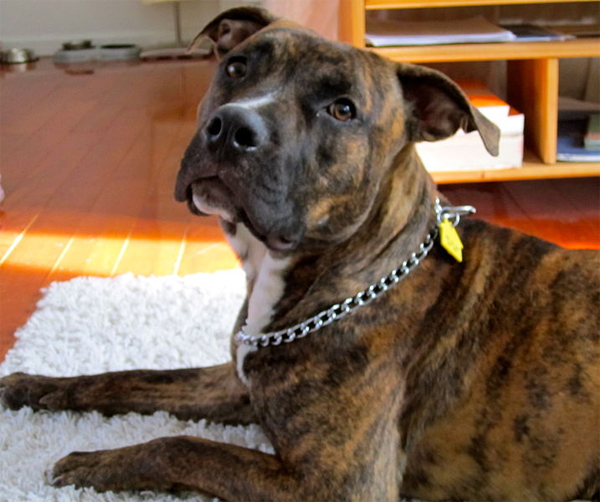Brindle Pitbull dogs have dark coats with black and tan flecks. They are solid, muscular dogs with short coats with dark feet and noses. Their tiger striped brindle fur can cover most of their body, but they often have a large white patch on their chests and legs. Brindle Pitbull puppies are intelligent, affectionate, protective and loyal companions, despite their controversial bull baiting and fighting ancestry. When most of us refer to a brindle Pitbull we are talking about a brindle patterned American Pitbull Terriers, but the term can be applied to Staffordshire Bull Terriers, Mini Staffordshire Bull Terriers and English Bull Terriers too. Today we’ll learn all about the brindle Pitbull. We’ll share how these cute coat markings could impact your dog’s personality, characteristics, behaviors or trainability. Helping you to decide whether a brindle dog is the right new pet for your family and lifestyle.
Your brindle Pitbull will need lots of socialization from the time they arrive home, to help them to feel happy and secure around strangers. They will also benefit from positive reinforcement training, and plenty of exercise each day. Brindle Pitbull dogs also benefit hugely from living in active homes, where they can be around their family for most of the day. This will help to avoid destructive behavior like chewing, and separation anxiety. With proper socialization and training they can be well-suited to life as a family pet.
Pitbull is the common name for a breed of dog that is called either the American Staffordshire Terrier or the American Pit Bull Terrier.
The term brindle is used to describe a dog’s coat coloring. Brindle markings on a dog are generally composed of alternating stripes of red/yellow hair and black/brown hair. Beautiful brindle patterns are irregular and vary from dog to dog, with some being more like tiger stripes and others like soft swirls.
Besides the Pitbull, other breeds that often have brindle markings include the Greyhound, Boxer, and French Bulldog. Brindle coat coloring is what’s known in genetics as a phenotype. A phenotype is an observable physical trait that is influenced by an animal’s genetics. A cat’s tabby coat pattern is a similar phenotype!
Important Reverse Brindle Pitbull Information

As aforementioned, reverse brindle Pitbulls share the same characteristics as other normal brindle Pitbulls.
Nevertheless, here is some little information that you may need to know about brindle Pitbulls in general:
Blue Nose Brindle Pitbulls
The skins on their noses are slightly bluish-grey.
They have soft blue or grey colorings in their coat markings.
The blue color may alternate with light brown or another color.
Blue brindle pits also tend to have some white coloration on their chest and feet.
The brindle patterned coat forms as a result of a phenotype.
A phenotype is a trait that we can physically observe which was formed by the animals’ genetics. The same thing happens to humans which is why we all have different hair colors and types.
FAQ
Is reverse blue brindle rare?
Are brindle Pitbulls rare?